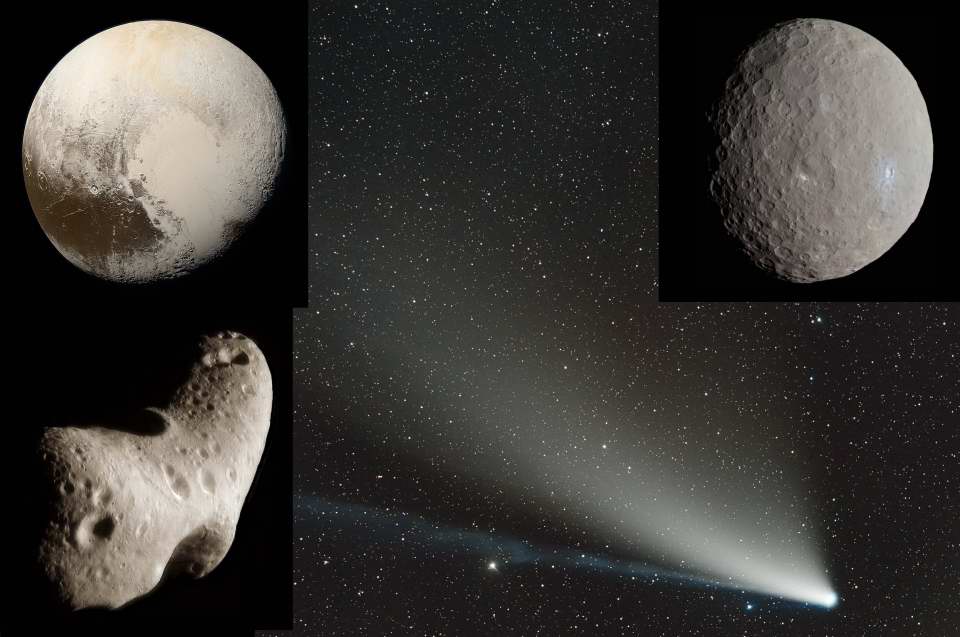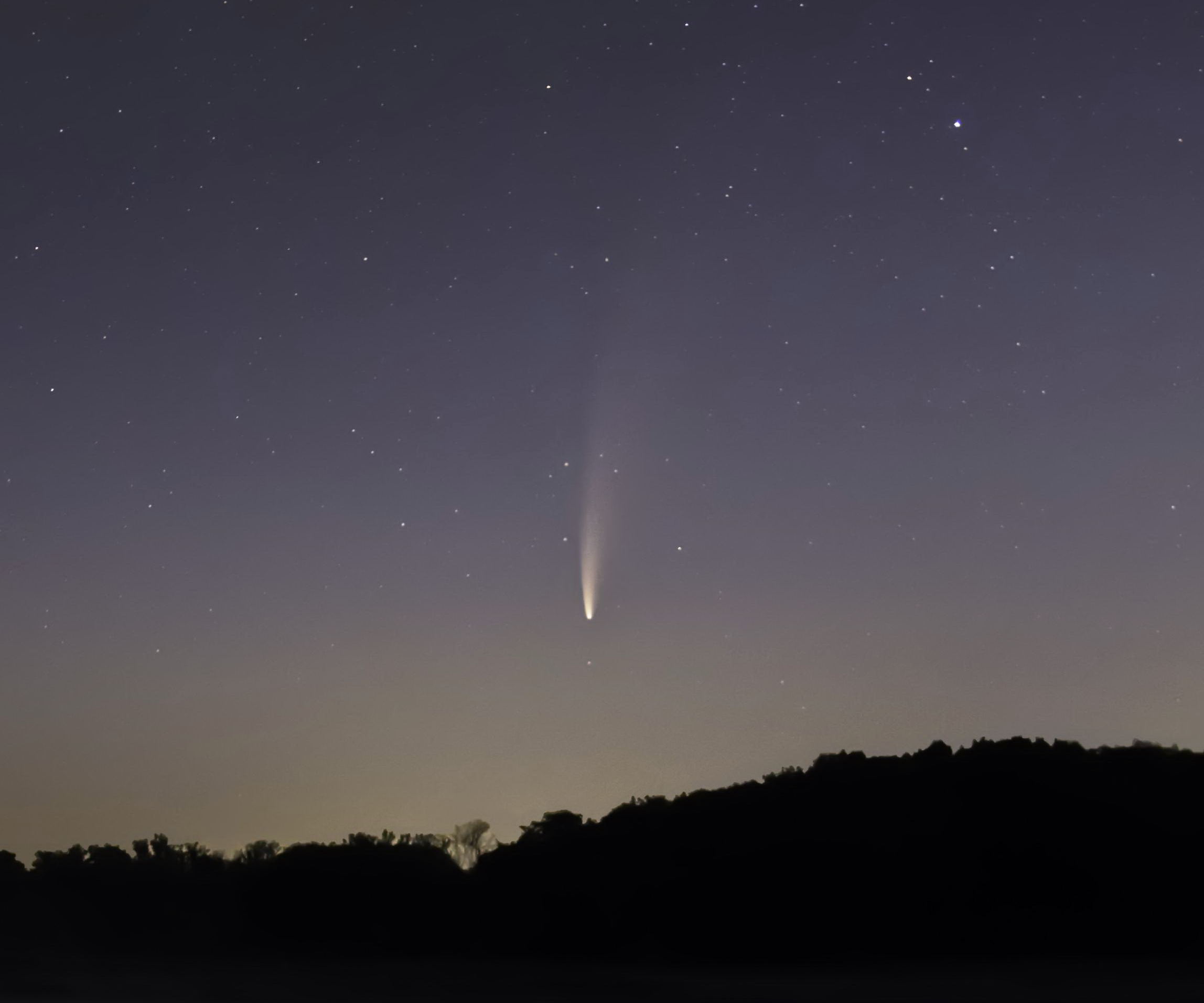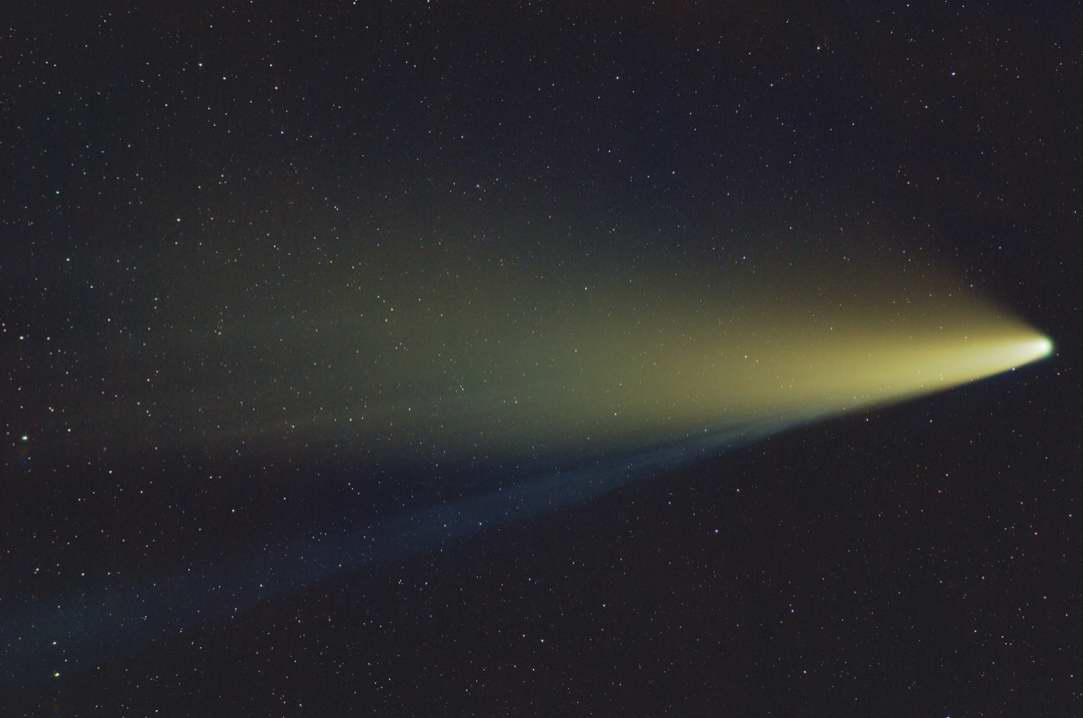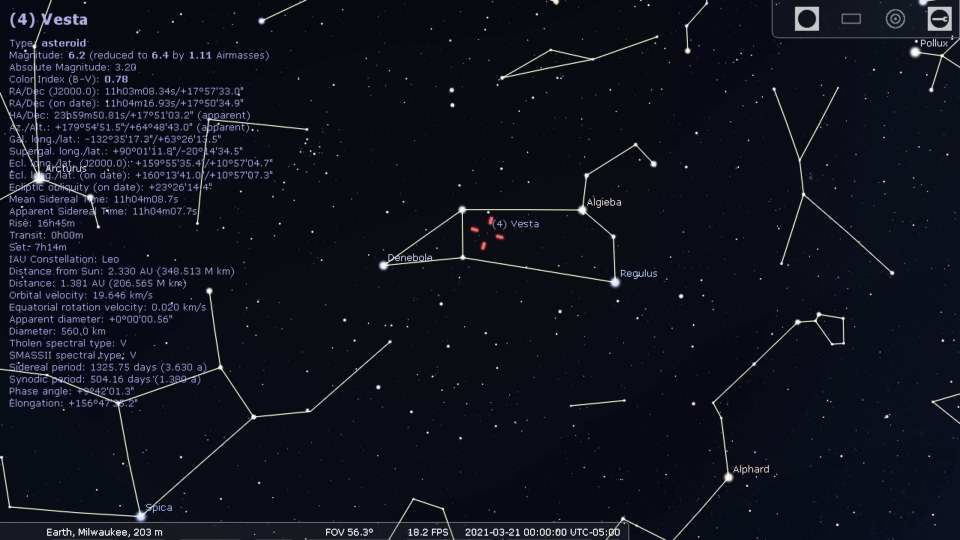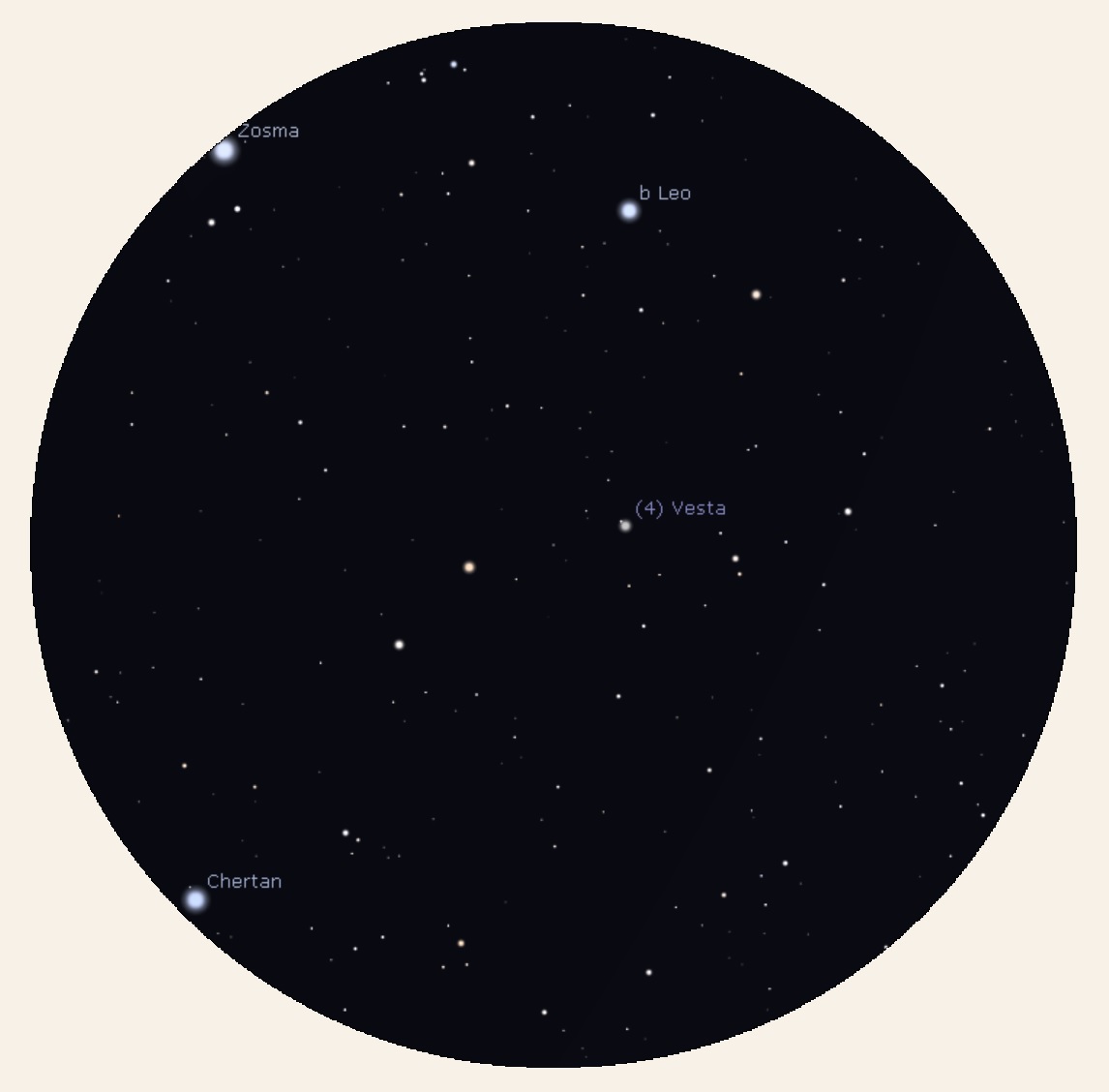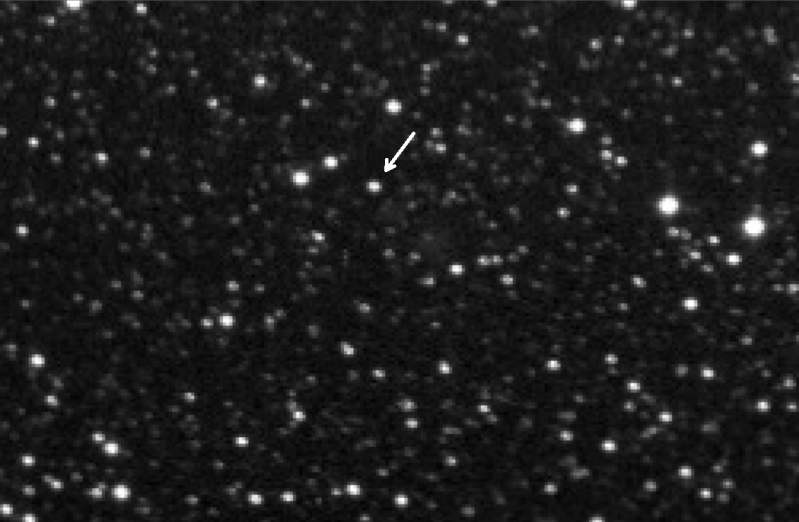Beginner's Guide
Comets / Asteroids / Dwarf Planets
No discussion about the solar system would be complete without mentioning the smaller members. There are actually two groups: Dwarf Planets and Small Solar System Bodies (SSSB). Though they may be small, they make up for it in their large numbers. There are nearly 4000 discovered comets, but they suspect the actual number is over a trillion when they include the Oort Cloud. There are over one million discovered asteroids, and they suspect there are 150 million asteroids in the inner solar system that are at least 100 meters in size. Finally, there are Dwarf Planets which are between regular planets and asteroids, and Centaurs which are half asteroid, half comets.
Comets
The most enigmatic members of the solar system are the comets. They are not seen as regular objects in the night sky like planets, but at any given time there is at least one comet that can be seen in telescope. However, nearly every year a comet will be bright enough to be seen in binoculars and then, occasionally, one will be bright enough to be seen without optical aid. The naked-eye comets are simply spectacular. Comets will normally stay in view for a few weeks and then disappear.
The brightness of a comet depends on several factors: 1) size, 2) how close they get to the Earth, 3) their surface reflectivity (what astronomers call albedo), and 4) how much material comes off the comet (i.e., the tail). The really bright comets generally have all of these elements working in their favor. In 2020 Comet Neowise (C/2020 F3) was especially bright and received a lot of attention which it deserved.
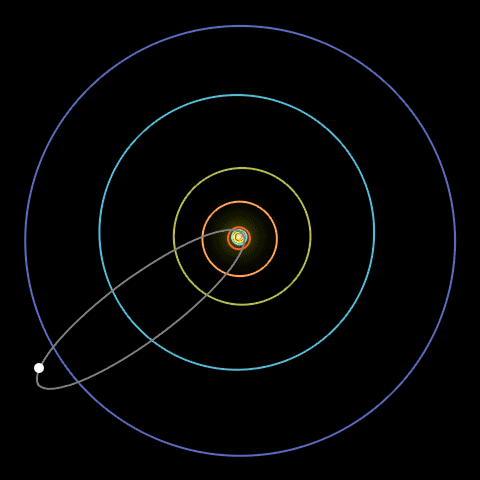
|
|
Highly elliptical orbit of Comet Halley. The four outer circles are for Jupiter, Saturn, Uranus, and Neptune. |
Orbit
Almost all comets are permanent members of the solar system because they orbit the sun. That orbit is an ellipse (just like the planets), but is wildly eccentric in comparison. The animation at the right shows the orbit of Comet Halley, easily the most famous comet. Its fame doesn't come from its brightness (though it is a naked-eye comet), but because it was the first comet determined to be periodic. Most comets are named for who discovered it, but not this one. It is named for astronomer Sir Edmund Halley who was checking the orbits of past comets and noticed that 3 of them appeared to be the same, returning every 76 years. When his prediction of the comet's return in 1758 came true, the comet was named in his honor.
The animation also shows the varying speed of the orbit. Anything in elliptical orbit (essentially everything that orbits the sun) travels fastest when it's closest to the sun and slowest when it's farthest.
Tail
The tail is what makes a comet so special. As you can see in the photo of a comet, there are two tails: dust and ion. The dust tail is yellow while the ion tail is blue.
No two comet tails are exactly the same because the composition of any comet nucleus is not the same. They are often described as "dirty snowballs" because their composition is dust, dirt, and ice (water), but they also contain frozen carbon dioxide, carbon monoxide, methane, and ammonia. The head of a comet is composed of the nucleus (the solid core) and the coma which is the material coming off that nucleus which will eventually be swept away via the solar wind.
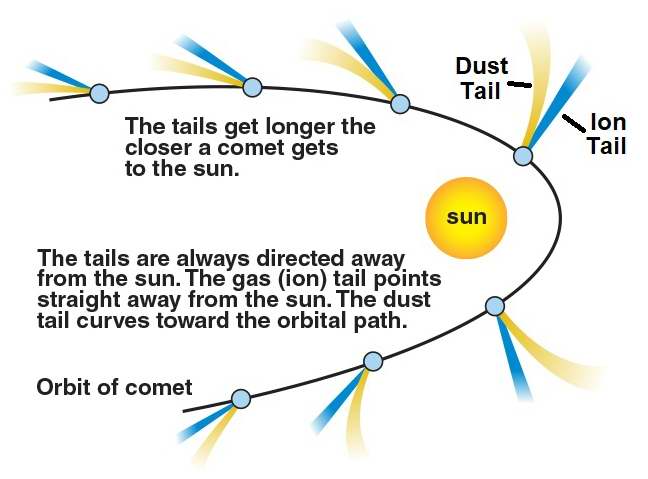 It may not be immediately intuitive because you'd naturally think the tail would always trail the comet trajectory. But a comets tail always
points opposite the sun. The tail is formed because as a comet nears the sun it heats up enough that
the volatile materials within the comet vaporize and stream out of the nucleus, carrying dust also. Separate tails are formed from the dust and gases.
The solar wind then blows them from the comet nucleus which is why the direction is always away from the sun. The other consequence is that the
comet tail will be longer when it's closest to the sun.
It may not be immediately intuitive because you'd naturally think the tail would always trail the comet trajectory. But a comets tail always
points opposite the sun. The tail is formed because as a comet nears the sun it heats up enough that
the volatile materials within the comet vaporize and stream out of the nucleus, carrying dust also. Separate tails are formed from the dust and gases.
The solar wind then blows them from the comet nucleus which is why the direction is always away from the sun. The other consequence is that the
comet tail will be longer when it's closest to the sun.
Naming the Comets
Over time the naming system for comets has evolved as the rate of discovery increased. Traditionally comets were named for the discoverer(s). An example is Comet Hale-Bopp which was independently discovered in 1995 by Alan Hale and Thomas Bopp. But in the cases of periodic comets, they are named for the astronomer who determined the periodicity rather than the first one to observe it. Halley's Comet (or Comet Halley) is an example.
Today comets are given specific designations based on a system established in 1994. Comet Hale-Bopp is actually Comet C/1995 O1 Hale-Bopp and Halley's Comet is Comet 1P/1682 Q1 Halley. For a complete discussion on the current and past naming conventions, we recommend you read the Wikipedia article.
Comets and Meteor Showers
Comet debris is the source of meteor showers, except for the Geminid's which have an asteroid. But not all comets! The ones that contribute to the yearly showers are those whose path crosses the Earth's orbit. This is why individual meteor showers happen at the same time every year.
Halley's Comet is unique in that it crosses the orbit of Earth in two places. Consequently it is associated with two meteor showers: the Eta Aquarids which occur in May and the Orionids which occur in October.
The Leonids are one of the major meteor showers of the year which peak in mid-November, but the hourly rate at maximum is only about 20 meteors per hour so they don't get much attention. The source of these meteors is Comet P55/Temple-Tuttle whose period is only 33 years. But this means that once every 33 years the path of this comet crosses the Earth's orbit which deposits a fresh debris field so the resulting meteor shower often becomes what we call a meteor storm. Hourly rates up to 1400 (40 per second) have been observed!
Observing Comets
Most comets are faint. And be wary of brightness estimates because they will make it seem they are much brighter than they will actually appear. That is because those brightness estimates are for the total brightness and this is spread out over a large area. For most comets you are going to need a star chart or specific celestial coordinates. Because a comet is continually in motion, those numbers must be associated with a specific date.
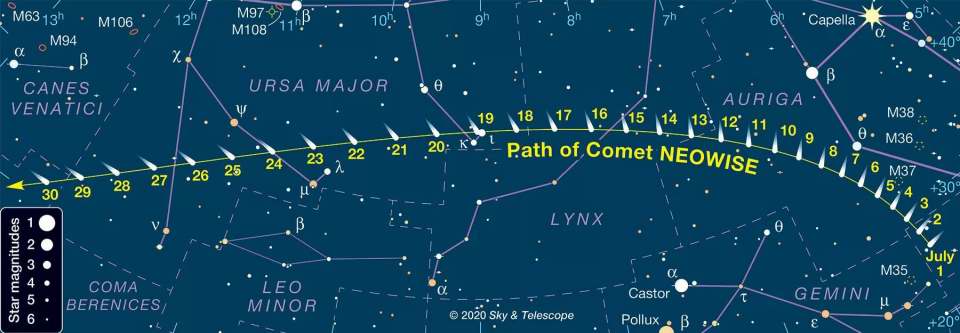 © 2020 Sky & Telescope Used by permission.
© 2020 Sky & Telescope Used by permission.
A great resource for the brighter comets is Sky & Telescope who will almost always publish a finder guide like the one shown above for the brighter comets which appear.
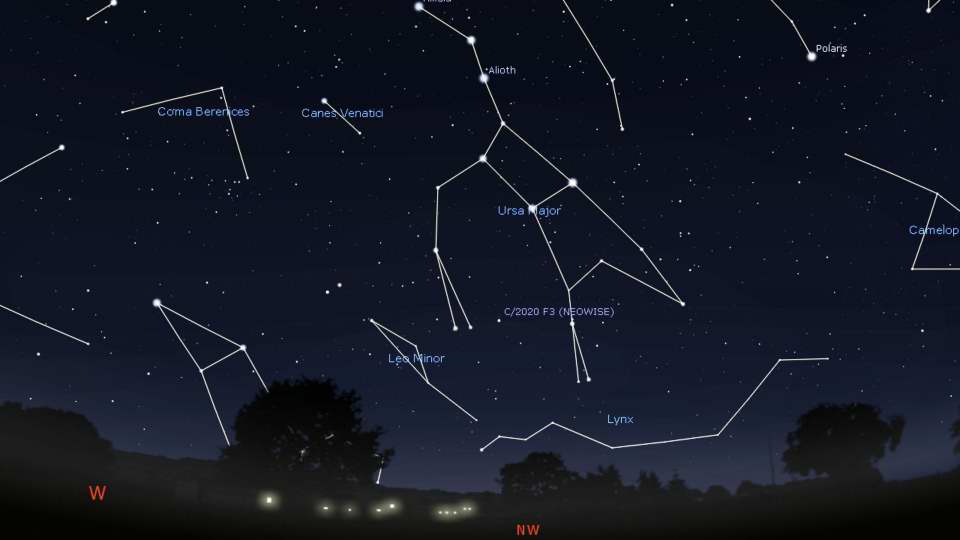 Another method for locating a comet is with a planetarium program. Here we again using Stellarium as our example. The Stellarium
screenshot on the right shows the position on the given date which was in the constellation Ursa Major. Though this method works really great,
getting new comet data can be a real challenge.
Another method for locating a comet is with a planetarium program. Here we again using Stellarium as our example. The Stellarium
screenshot on the right shows the position on the given date which was in the constellation Ursa Major. Though this method works really great,
getting new comet data can be a real challenge.
Finally another great resource for comets is The Sky Live. At the top of their home page they have links to find comets, asteroids, and the planets.
Asteroids
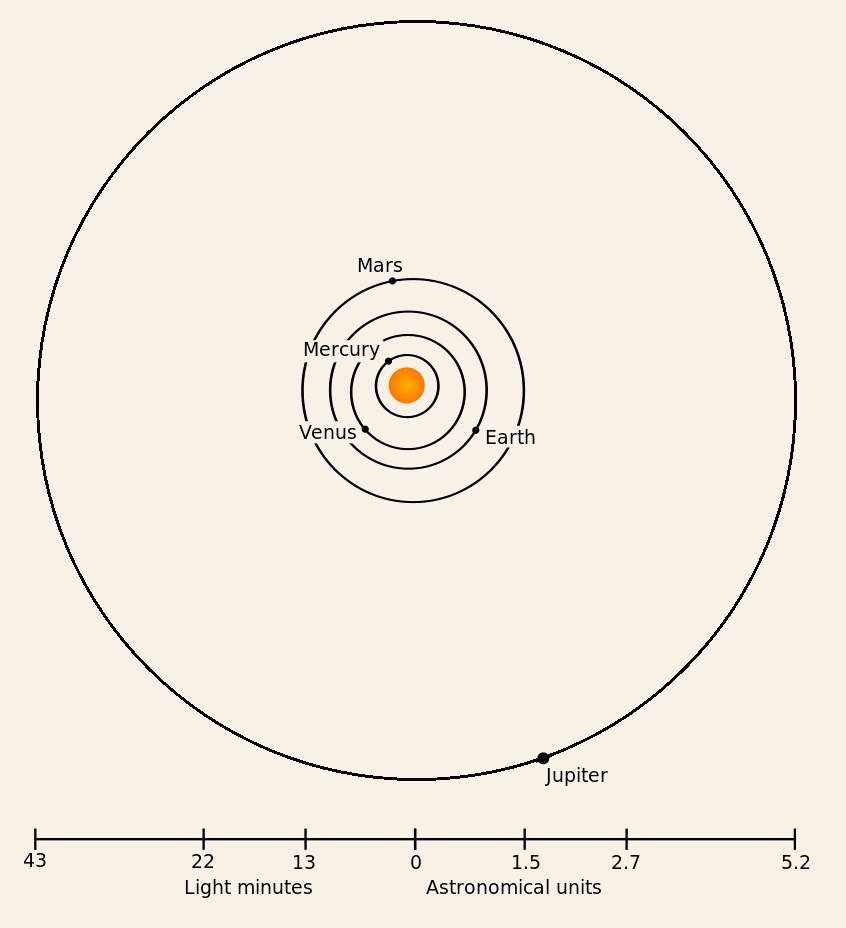 Ever since astronomers knew
the relative distances of the planets they noticed an inordinately wide gap between the orbits of Mars and Jupiter. It just seemed like something should
be there. And in the wildest of imaginations, maybe even a planet. But why should there be one? It wasn't as if there was some magical
formula that dictated the distances of the planets. But what if there were? This will be the story of the missing planet.
Ever since astronomers knew
the relative distances of the planets they noticed an inordinately wide gap between the orbits of Mars and Jupiter. It just seemed like something should
be there. And in the wildest of imaginations, maybe even a planet. But why should there be one? It wasn't as if there was some magical
formula that dictated the distances of the planets. But what if there were? This will be the story of the missing planet.
Johann Bode
In 1771 astronomer Johann Bode in Germany thinks he has this "magical" formula. He is not the originator, but he is going to champion the idea so it will be widely known as Bode's Law. You start with the numbers 0 and 3. You double the 3 to get 6, double that to get 12, then 24, 48, and so on.
0, 3, 6, 12, 24, 48, 96, 192, 384, ...
Now add 4 to each of these values:
4, 7, 10, 16, 28, 52, 100, 196, 388, ...
Finally, divide each of the numbers by 10 and you get the following numbers which you then match up the distances to the known planets at that time in Astronomical Units (AU).
| Planet | Bode's Distance | Actual Distance |
|---|---|---|
| Mercury | 0.4 | 0.39 |
| Venus | 0.7 | 0.72 |
| Earth | 1.0 | 1.000... * |
| Mars | 1.6 | 1.52 |
| ??? | 2.8 | ??? |
| Jupiter | 5.2 | 5.2 |
| Saturn | 10.0 | 9.54 |
| 19.6 | ||
| 38.8 |
As you can see there's a good correspondance of the planet distances to the predicted value, except for 2.8 where there was no planet! So Bode is championing the notion that there must be a planet at this location and astronomers should be looking for it. However, Bode will almost be universally ignored for several reasons: 1) if there was a planet there, it should have already been discovered, 2) if something is actually there it would have to be faint and very difficult to locate, 3) the absence of a planet simply means his formula is wrong, and 4) there are only 6 planets - that's all the planets we have and will ever have.
The outlook will change dramatically in 1781 when British amateur astronomer William Herschel discovers a new planet which he proposes the name of Georgius Sidus (George's Star) in honor of King George. Of course this name will never be accepted outside of England, but it is shrewd move on Herschel's part as it will curry great favor with the king who will thereafter fund his astronomy activities making him a professional astronomer and allowing him to build ever larger telescopes.
When news of a new planet reaches Germany, no one is more excited than Johann Bode because his first thought is that Herschel has found his missing planet. But soon he is disappointed as the motion indicates the planet is well beyond his predicted position. So how far is it? It will be Bode himself who will gather the observations and finally determine the distance at 19.2 Astronomical Units. This distance corresponds almost exactly to the predicted position.
| Planet | Bode's Distance | Actual Distance |
|---|---|---|
| Mercury | 0.4 | 0.39 |
| Venus | 0.7 | 0.72 |
| Earth | 1.0 | 1.000... |
| Mars | 1.6 | 1.52 |
| ??? | 2.8 | ??? |
| Jupiter | 5.2 | 5.2 |
| Saturn | 10.0 | 9.54 |
| Uranus * | 19.6 | 19.2! |
| 38.8 |
Since the distance corresponded so well to prediction this gave Bode's Law considerable creedance so astronomers would start searching.
The Celestial Police
There are two ways of finding a new planet: looking through a telescope and noting there is a disc (how Herschel found Uranus) or plotting the position of a suspected planet against the static stars. If a star is noted that moves after just several nights, it must be an object in the solar system. Unfortunately, the second method is tedious and time consuming and at this point in history astronomers lacked good star atlases! After many years of fruitless searching, a plan was hatched in Germany to form the Celestial Police. Why this name? Because this missing planet was causing disorder in the solar system and they where going to restore it. The idea was to divide the ecliptic path into 24 sections giving each area to a different prominent astronomer. This way no ones work would overlap and this way this missing planet could be discovered quickly.
Letters were sent out in 1800, but on January 1, 1801 Sicilian astronomer Giuseppe Piazzi found something. Amazingly, though Piazzi was selected as a member of the Celestial Police, he had not yet received his invitation. At first Piazzi simply announced that what he found was probably a comet, but he suspected otherwise. When it was determined that Piazzi's object was 2.77 AU which fit almost perfectly into Bode's predicted position, the search was over. Piazzi would name this new planet Ceres and we now had 8 planets in the solar system. It was a little disappointing that the object was so small, but it made sense because had it been larger it would have been a naked-eye object and hence discovered much earlier.
| Planet | Bode's Distance | Actual Distance |
|---|---|---|
| Mercury | 0.4 | 0.39 |
| Venus | 0.7 | 0.72 |
| Earth | 1.0 | 1.000... |
| Mars | 1.6 | 1.52 |
| Ceres | 2.8 | 2.77! |
| Jupiter | 5.2 | 5.2 |
| Saturn | 10.0 | 9.54 |
| Uranus | 19.6 | 19.2 |
| ??? | 38.8 |
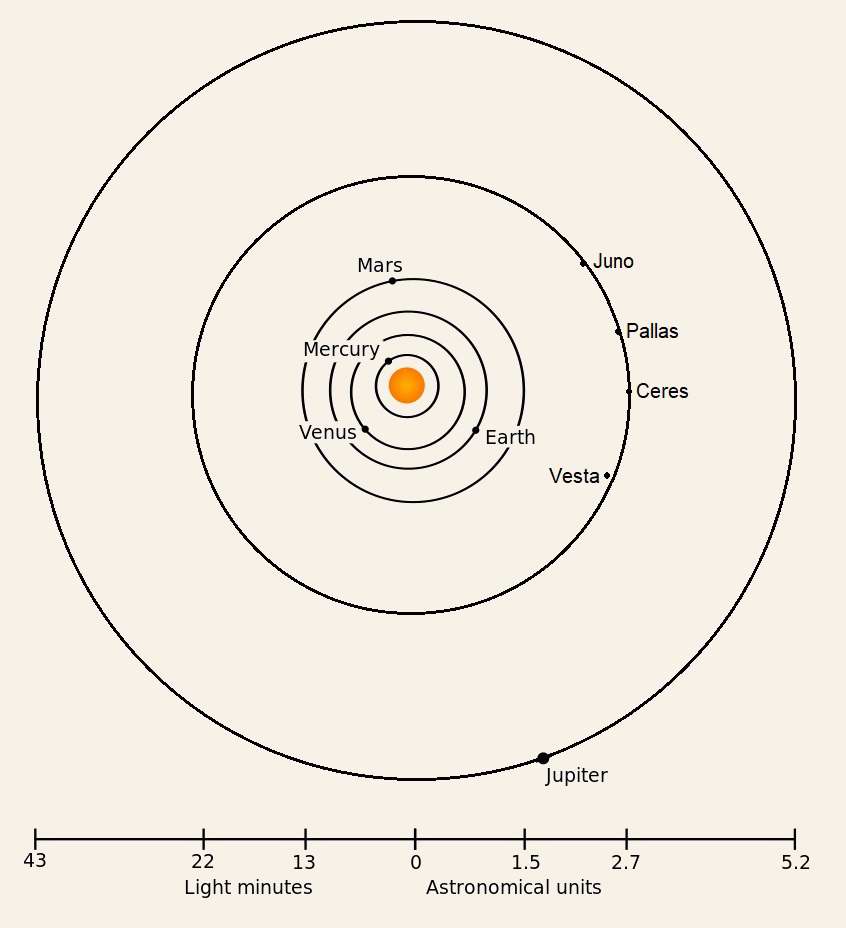 So at this point that could have been the end of the story. The Celestial Police should have disbanded, turning in their badges and going on
to other work. But they would tell you two things: 1) Badges? We don't have no
stinking badges! and 2)
Why would we quit? If Bode's Law is correct, and at this point nearly
everyone believes this, there will be another missing object: a planet
beyond the orbit of Uranus. So they keep the search going and in the
following year, 1802, one those policeman,
Heinrich Wilhelm Olbers discovered
Pallas. But it was another small body and at a distance of 2.77 AU, it was in the same general orbit as Ceres, so not the body they were
looking for. So continuing the search, in 1804 another small body is found by policeman Karl Ludwig Harding, Juno, at 2.67 AU. So it still continued
and in 1807 Olbers (who discovered Pallas) finds yet another, Vesta, at 2.36 AU.
So at this point that could have been the end of the story. The Celestial Police should have disbanded, turning in their badges and going on
to other work. But they would tell you two things: 1) Badges? We don't have no
stinking badges! and 2)
Why would we quit? If Bode's Law is correct, and at this point nearly
everyone believes this, there will be another missing object: a planet
beyond the orbit of Uranus. So they keep the search going and in the
following year, 1802, one those policeman,
Heinrich Wilhelm Olbers discovered
Pallas. But it was another small body and at a distance of 2.77 AU, it was in the same general orbit as Ceres, so not the body they were
looking for. So continuing the search, in 1804 another small body is found by policeman Karl Ludwig Harding, Juno, at 2.67 AU. So it still continued
and in 1807 Olbers (who discovered Pallas) finds yet another, Vesta, at 2.36 AU.
So at this point there were 11 planets in the solar system (a total of 22 objects when you include the known moons and Halley's Comet). But the situation with these multiple tiny bodies in this orbit are more than a little puzzling and there was some vocal dissent led by William Herschel who has the largest telescopes in the world. He argues how can you call these bodies planets when they appear to be just stars in his large telescopes? Herschel has another name of them: asteroids. It comes from the Greek "aster" which means star and "oid" which means like. "Star Like" - he wants to call them asteroids. But they will continue to be considered planets for many more years, mainly because after Vesta nothing is found. By 1815 the Celestial Police have disbanded and with no one looking it was hardly surprising that nothing was found.
Demise of Ceres, Pallas, Juno, and Vesta
The beginning of the end of these 4 new planets begins late in 1845 when a fifth one is discovered: Astraea. It was found entirely by accident because at the time it was extremely close to Vesta. It is much smaller than the first 4 and hardly anyone referred to it as a new planet. And a big reason is that less than a year later the big prize was captured: Neptune which became the 12th planet.
With the new found interest in searching for planetary bodies plus good atlases, more objects will be found between Mars and Jupiter. 3 were discovered in 1847, 1 in 1848, 1 in 1849, 3 in 1850, and 11 between 1851-1855. From this time going forward there won't be a single listing of planets that includes Ceres, Pallas, Juno, and Vesta and they will then be referred to as either asteroids or minor planets. Of course, the discoveries will not end. There will be 100 found by 1868, 1000 by 1921 (the era of photography had begun), 10,000 by 1989, 100,000 by 2005 (the era of digital imaging had begun), and as of 2020, it is 1 million. The actual number is estimated in the millions.
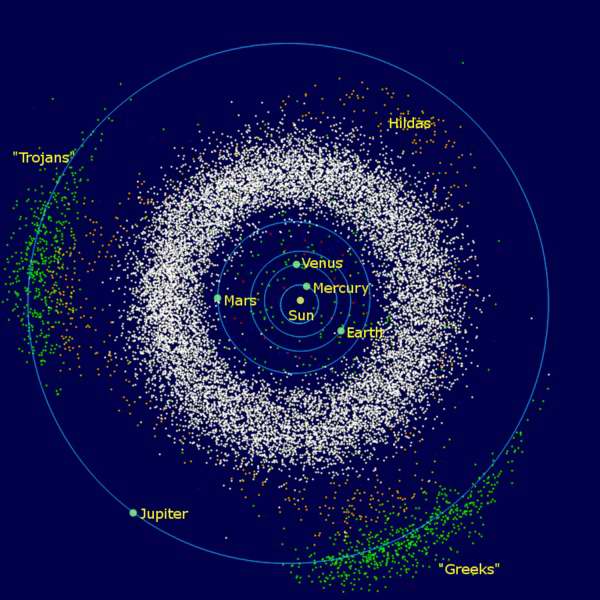 The diagram at the right shows the distribution of asteroids in the inner solar system. The largest group we call the
Main Asteroid Belt. That is the donut shaped group in white.
But you can see there are other groups as well. Those in green are
Jupiter's Trojan asteroids comprised of the Greeks and Trojans groups.
Those in orange are the
Hilda asteroids.
The last group (unmarked) are located within the orbit of Mars which include the notorius
Near-Earth objects.
Discussion of these are out of the scope of this beginner's guide, but follow the links if you want more information.
The diagram at the right shows the distribution of asteroids in the inner solar system. The largest group we call the
Main Asteroid Belt. That is the donut shaped group in white.
But you can see there are other groups as well. Those in green are
Jupiter's Trojan asteroids comprised of the Greeks and Trojans groups.
Those in orange are the
Hilda asteroids.
The last group (unmarked) are located within the orbit of Mars which include the notorius
Near-Earth objects.
Discussion of these are out of the scope of this beginner's guide, but follow the links if you want more information.
We must mention that when the distance of Neptune was established at 30.1 AU, it discredited Bode's Law because the predicted distance was 38.8 AU. Today we consider any correspondence between Bode's Law and the distances a coincidence and there is nothing in the laws of gravity which would dictate the distances.
Observation
Unfortunately there is not much to see when you view any of the asteroids in a telescope. The best you can do is try to find them and for that you will need a star chart with the target asteroid plotted. For the brighter asteroids you can create a chart from Stellarium (and probably any other planetarium program) who have the orbits of the major asteriods so they can be displayed.
You will need a zoomed in image (like the right hand image) to actually identify Vesta (or any asteroid or dwarf planet), but the left image is needed for you to locate the close up images.
Dwarf Planets
The story of dwarf planets is really the story of Pluto and how it went from definitely being a planet until it was reclassified.
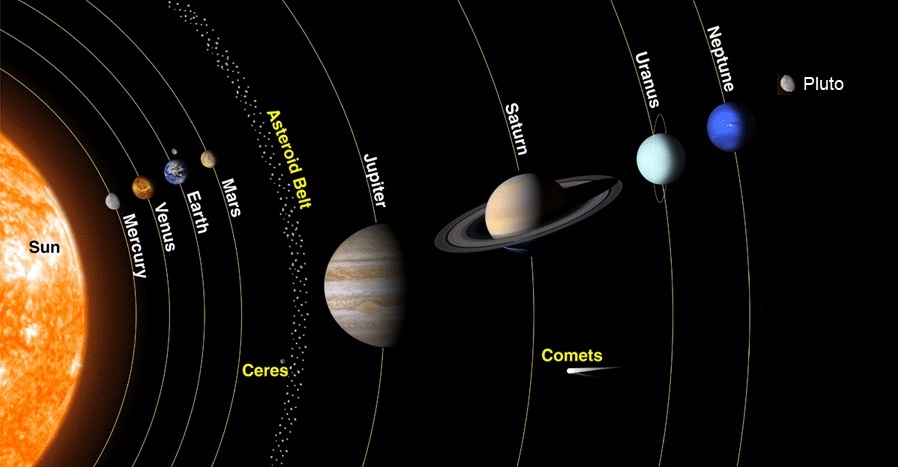
The diagram above shows the solar system when Pluto was discovered in 1930. At that time there were about 1500 known objects: 8 planets, 25 moons, about 30 periodic comets (i.e., comets that had orbits calculated showing they were members of the solar system), and the rest minor planets (i.e., objects in the Main Asteroid Belt). At that time only the one asteroid belt was known. The point here is that we still had a relatively simple solar system. The leading theory for the asteroids was that there was a planet there which got to close to Jupiter and got ripped apart. (Today, we believe there was never a planet and that the gravity of Jupiter prevents one from ever forming.) So after Pluto's discovery, there was little doubt it should be a planet.
The Definition of a Planet
What exactly is a planet? The name planet comes from Greeks and means wanderer. When the ancients looked into the heavens they saw 5000+ stars and though they saw them rotate in the sky, the stars didn't change positions in relation to other stars. But 5 of those "stars" were different because their positions changed. These they labeled the planets: Mercury, Venus, Mars, Jupiter, and Saturn. Of course there was also the Sun and Moon which also "wander" but these were always in their own classes since they appeared to be discs in the sky whereas the "planets" merely looked like stars. We lived in what we call a geocentric (Earth centered) universe.
Planet Definition: Object that wanders in the sky, excluding the Sun and Moon.
This would change starting in 1543 when Nicolaus Copernicus' work "On the Revolutions of the Heavenly Spheres" was published advocating that the Sun was the center of our solar system / universe. He was hardly the first one to come to this conclusion, but we give most of the credit to Copernicus because it was his work that got the ball rolling on the acceptance of what we call the Helocentric (Sun centered) model. But this necessitated a change to the definition of a planet. A planet was now defined as any body that directly orbited the Sun. The consequence of this change was that suddenly Earth was just another planet orbiting the Sun. And the Moon could not be considered a planet because it orbited the Earth. However, you should note that the concept of "wandering" has never gone away. We discover new bodies in the solar system all the time and that is the thing astronomers look for to identify them.
Planet Definition: Object that directly orbits the Sun.
A slight change to that definition came in 1758 with the appearance of Halley's Comet. It's called Halley's Comet because Sir Edmund Halley predicted this comets return because he thought it was the same comet from 1531, 1607, and 1682 which all seemed to have the same orbit and if true would again appear in 1758. The point here is that this was proof that some comets actually orbit the sun. So technically a comet would be a planet, but comets were decidely different from the known planets so the definition changed by specifically excluding comets.
Planet Definition: Object that directly orbits the Sun with the exception of comets.
Another change will occur starting after Neptune was discovered in 1847 because more and more small bodies were discovered orbiting between Mars and Jupiter. The bodies became known as either minor planets or asteroids that this area became known as the asteroid belt. Consequently Ceres, Pallas, Juno, and Vesta which were considered planets were reclassified.
Planet Definition: Object that directly orbits the Sun with the exception of comets and asteroids.
Planet Pluto
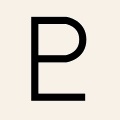 The existence of Pluto was predicted by
Percival Lowell to explain the orbital anomalies of Uranus and Neptune.
His calculations gave a a general location and indicated it should have
7 Earth masses. He was very wealthy and had his own observatory (Lowell
Observatory) and searched for what he called Planet X until he died
in 1916 without success. It wasn't until 1930 when it was finally
discovered at the Lowell Observatory near the predicted position. The
symbol of Pluto is a stylized P and L which is a nod to Percival Lowell.
The existence of Pluto was predicted by
Percival Lowell to explain the orbital anomalies of Uranus and Neptune.
His calculations gave a a general location and indicated it should have
7 Earth masses. He was very wealthy and had his own observatory (Lowell
Observatory) and searched for what he called Planet X until he died
in 1916 without success. It wasn't until 1930 when it was finally
discovered at the Lowell Observatory near the predicted position. The
symbol of Pluto is a stylized P and L which is a nod to Percival Lowell.
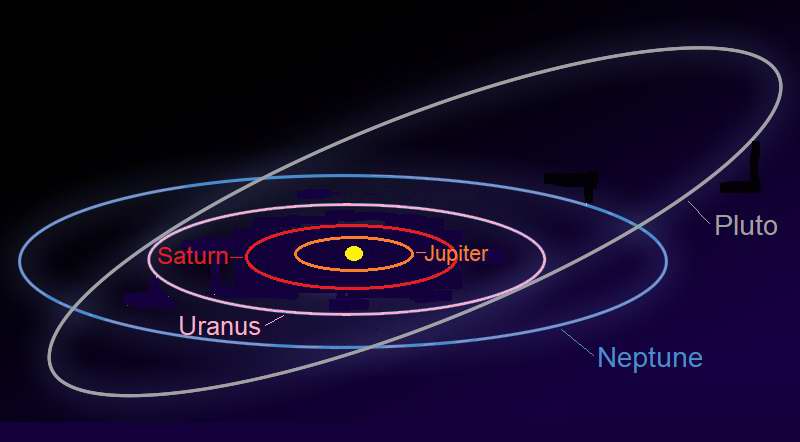 But over time there came increasing doubts. Immediately Pluto's orbit was decidedly different
from the other planets. The
eccentricity of Pluto's orbit was far greater than any other and
there are times when Pluto is closer to the sun than Neptune! Also, the
inclination
of the orbit is 17 degrees to the rest of the solar system as shown in the
diagram to the right.
But over time there came increasing doubts. Immediately Pluto's orbit was decidedly different
from the other planets. The
eccentricity of Pluto's orbit was far greater than any other and
there are times when Pluto is closer to the sun than Neptune! Also, the
inclination
of the orbit is 17 degrees to the rest of the solar system as shown in the
diagram to the right.
 Another issue was the mass/size of Pluto. A disc could not be detected and in 1931 Pluto's size was first estimated
and that size was the same as Earth's
based on calculations of the gravitation effect it had on Uranus and Neptune. Also, that value seemed to be consistent
since that would be brightness if Earth were at
Pluto's distance. In 1948 the size was lowered substantially as new calculations of the gravitonal effect put its
mass/size between Mercury and Mars.
In 1976 another downsizing happened when it was
determined that the surface of Pluto was much more reflective (albedo)
giving it a size slightly smaller than the Moon. Then in 1978 there was
another major downsizing because a satellite was discovered and what we
thought was Pluto was really the planet and it's moon. The measurement
of the period gave a good measure of its mass which indicated a size about 2/3rds that of the moon. But Pluto's status as a planet
was still intact.
Another issue was the mass/size of Pluto. A disc could not be detected and in 1931 Pluto's size was first estimated
and that size was the same as Earth's
based on calculations of the gravitation effect it had on Uranus and Neptune. Also, that value seemed to be consistent
since that would be brightness if Earth were at
Pluto's distance. In 1948 the size was lowered substantially as new calculations of the gravitonal effect put its
mass/size between Mercury and Mars.
In 1976 another downsizing happened when it was
determined that the surface of Pluto was much more reflective (albedo)
giving it a size slightly smaller than the Moon. Then in 1978 there was
another major downsizing because a satellite was discovered and what we
thought was Pluto was really the planet and it's moon. The measurement
of the period gave a good measure of its mass which indicated a size about 2/3rds that of the moon. But Pluto's status as a planet
was still intact.
The beginning of the end started in 1992 with the discovery of another small body in the same general orbit as Pluto. And month after month, and soon week after week more would be found and it became clear this was a previously unknown asteroid field which we now call the Kuiper Belt with Pluto simply being the largest member of that group. The final straw came when Eris was found. It appeared to be larger than Pluto although it was a lot further away in yet another asteriod field which we call the Scattered Disc.
Planet Pluto - 1930-2006
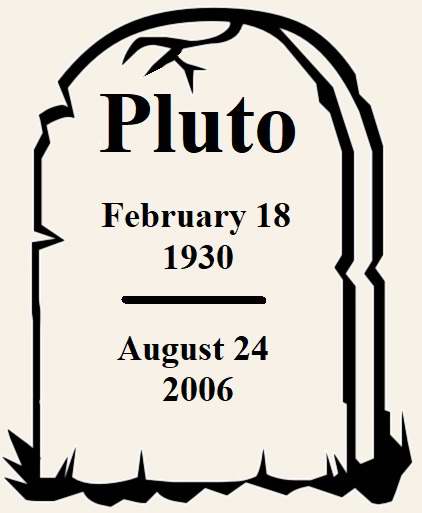 In 2006 Pluto's reign as a full planet came to an end when International Astronomers Union voted to adopt an official definition of a
planet. To be considered a planet, it must fulfill three criteria:
In 2006 Pluto's reign as a full planet came to an end when International Astronomers Union voted to adopt an official definition of a
planet. To be considered a planet, it must fulfill three criteria:
- is in orbit around the Sun,
- has sufficient mass to assume hydrostatic equilibrium (a nearly round shape), and
- has "cleared the neighborhood" around its orbit.
If a solar system body only fulfills the first two criteria, it is considered a Dwarf Planet. Pluto satisfies the first two criteria, but fails number 3 because a planet cannot be part of an asteroid belt.
A curious consequence of this definition makes the position of a solar system body extremely important. For example I think everyone can agree that Earth is a planet. However, if Earth were at the distance of Pluto, it would not have cleared the Kuiper Belt so therefore would not be considered a planet.
Other Dwarf Planets
Eris obviously met the definition of a dwarf planet since it's more massive than Pluto, though it's size is just a bit smaller. Also asteroids Makemake and Haumea which lie in the Kuiper Belt. But a big surprise was that Ceres in the main asteroid belt met this definition so it is now considered a dwarf planet. There are other candidate dwarf planets, but so far the complete list of dwarf planets is Pluto, Eris, Makemake, Haumea, and Ceres. Astronomers believe there are many more, but in order to know whether the object has a great enough mass to be in hydrostatic equilibrium (i.e., round) it must have a satellite or been visited by a space craft to get a close enough image.
Observation
Unfortunately in any amateur telescope a dwarf planet is going to look like a star. Only Ceres can be seen in binoculars. And to see them will require a star chart. However, via imaging you can see the position change over several nights. These images of the field showing Pluto were taken by an MAS member and it was images like these, though taken on film, is how Pluto was discovered.

